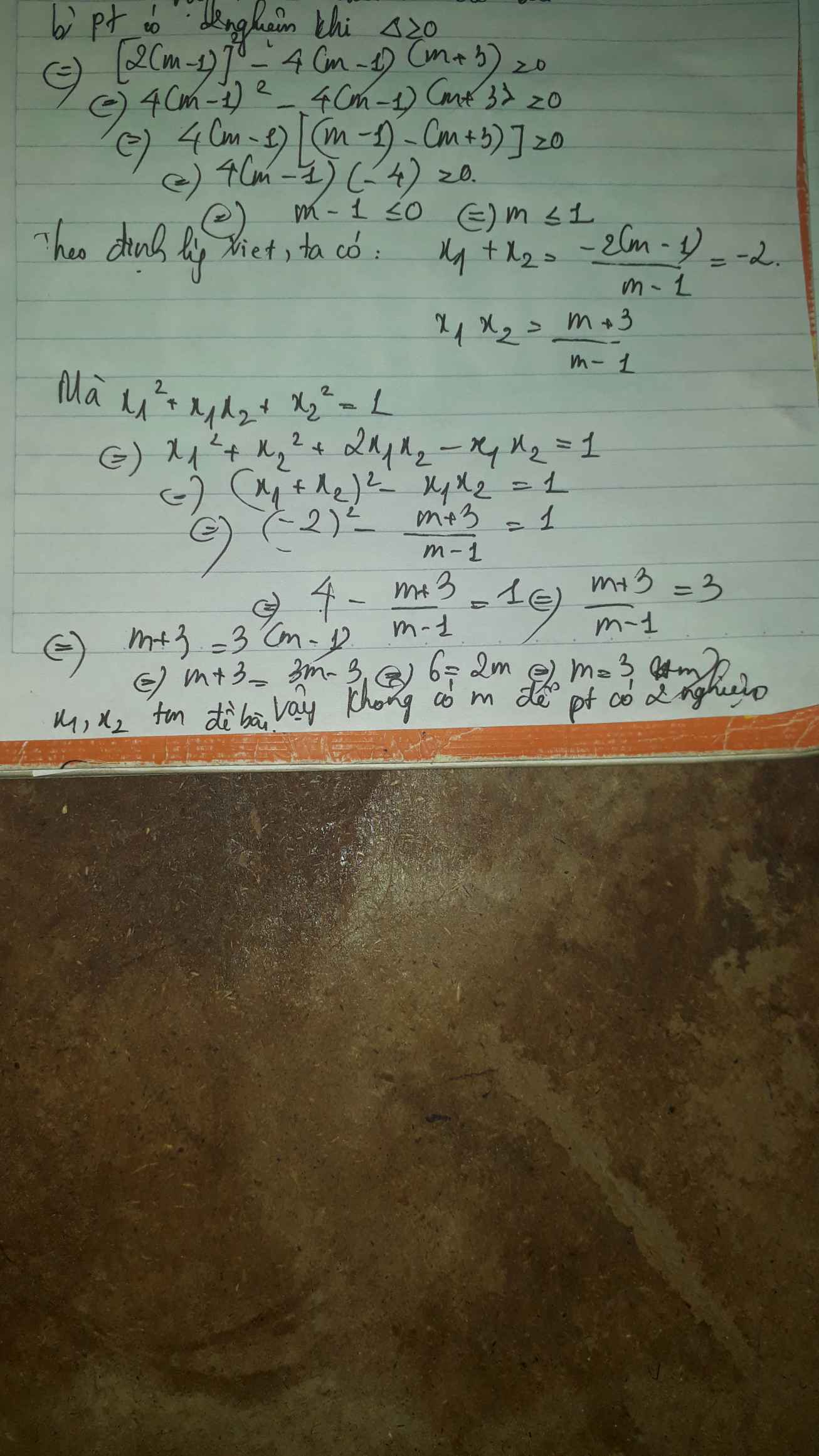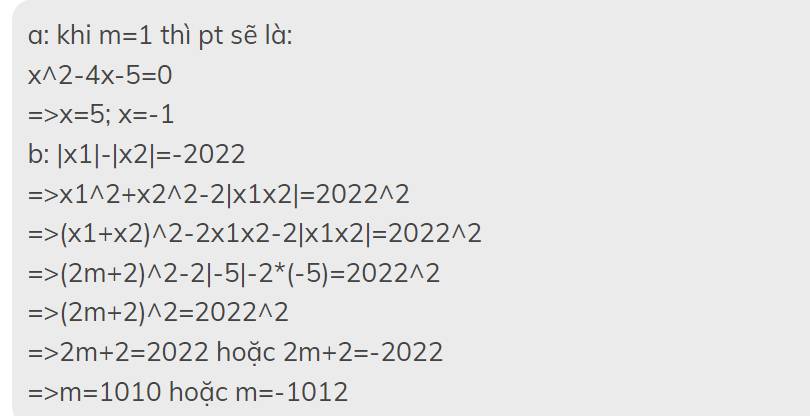Hãy nhập câu hỏi của bạn vào đây, nếu là tài khoản VIP, bạn sẽ được ưu tiên trả lời.

a, bạn tự làm
b, Thay x = 3 vào pt trên ta được
\(9-3m-3=0\Leftrightarrow6-3m=0\Leftrightarrow m=2\)
Thay m = 2 vào ta được \(x^2-2x-3=0\)
Ta có a - b + c = 1 + 2 - 3 = 0
vậy pt có 2 nghiệm x = -1 ; x = 3
c, \(\Delta=m^2-4\left(-3\right)=m^2+12>0\)
vậy pt luôn có 2 nghiệm pb
\(x_1x_2+5\left(x_1+x_2\right)-1997=0\)
\(\Rightarrow-3+5m-1997=0\Leftrightarrow5m-2000=0\Leftrightarrow m=400\)

Phương trình có : \(\Delta=b^2-4ac=\left[-\left(m+1\right)\right]^2-4.1.\left(-2\right)\)
\(\Rightarrow\Delta=\left(m+1\right)^2+8>0\)
Suy ra phương trình có hai nghiệm phân biệt với mọi \(m\).
Theo định lí Vi-ét : \(\left\{{}\begin{matrix}x_1+x_2=m+1\\x_1x_2=-2\end{matrix}\right.\)
Theo đề bài : \(\left(1-\dfrac{2}{x_1+1}\right)^2+\left(1-\dfrac{2}{x_2+1}\right)^2=2\)
\(\Leftrightarrow\dfrac{\left(x_1-1\right)^2}{\left(x_1+1\right)^2}+\dfrac{\left(x_2-1\right)^2}{\left(x_2+1\right)^2}=2\)
\(\Leftrightarrow\dfrac{\left[\left(x_1-1\right)\left(x_2+1\right)\right]^2+\left[\left(x_2-1\right)\left(x_1+1\right)\right]^2}{\left[\left(x_1+1\right)\left(x_2+1\right)\right]^2}=2\)
\(\Leftrightarrow\left[\left(x_1-1\right)\left(x_2+1\right)\right]^2+\left[\left(x_2-1\right)\left(x_1+1\right)\right]^2-2\left[\left(x_1+1\right)\left(x_2+1\right)\right]^2=0\)
\(\Leftrightarrow\left(x_2+1\right)^2\left[\left(x_1-1\right)^2-\left(x_1+1\right)^2\right]+\left(x_1+1\right)^2\left[\left(x_2-1\right)^2-\left(x_2+1\right)^2\right]=0\)
\(\Leftrightarrow-4x_1\left(x_2+1\right)^2-4x_2\left(x_1+1\right)^2=0\)
\(\Leftrightarrow x_1x_2^2+2x_1x_2+x_1+x_1^2x_2+2x_1x_2+x_2=0\)
\(\Leftrightarrow x_1x_2\left(x_1+x_2\right)+4x_1x_2+\left(x_1+x_2\right)=0\)
\(\Rightarrow-2\left(m+1\right)+4\cdot\left(-2\right)+m+1=0\)
\(\Leftrightarrow m=-9\)
Vậy : \(m=-9.\)

b) phương trình có 2 nghiệm \(\Leftrightarrow\Delta'\ge0\)
\(\Leftrightarrow\left(m-1\right)^2-\left(m-1\right)\left(m+3\right)\ge0\)
\(\Leftrightarrow m^2-2m+1-m^2-3m+m+3\ge0\)
\(\Leftrightarrow-4m+4\ge0\)
\(\Leftrightarrow m\le1\)
Ta có: \(x_1^2+x_1x_2+x_2^2=1\)
\(\Leftrightarrow\left(x_1+x_2\right)^2-2x_1x_2=1\)
Theo viet: \(\left\{{}\begin{matrix}x_1+x_2=-\dfrac{b}{a}=2\left(m-1\right)\\x_1x_2=\dfrac{c}{a}=m+3\end{matrix}\right.\)
\(\Leftrightarrow\left[-2\left(m-1\right)^2\right]-2\left(m+3\right)=1\)
\(\Leftrightarrow4m^2-8m+4-2m-6-1=0\)
\(\Leftrightarrow4m^2-10m-3=0\)
\(\Leftrightarrow\left[{}\begin{matrix}m_1=\dfrac{5+\sqrt{37}}{4}\left(ktm\right)\\m_2=\dfrac{5-\sqrt{37}}{4}\left(tm\right)\end{matrix}\right.\Rightarrow m=\dfrac{5-\sqrt{37}}{4}\)

a: khi m=1 thì pt sẽ là:
x^2-4x-5=0
=>x=5; x=-1
b: |x1|-|x2|=-2022
=>x1^2+x2^2-2|x1x2|=2022^2
=>(x1+x2)^2-2x1x2-2|x1x2|=2022^2
=>(2m+2)^2-2|-5|-2*(-5)=2022^2
=>(2m+2)^2=2022^2
=>2m+2=2022 hoặc 2m+2=-2022
=>m=1010 hoặc m=-1012

Theo vi ét:
\(\hept{\begin{cases}a_1a_2=1\\a_1+a_2=-p\end{cases}}\) và \(\hept{\begin{cases}b_1b_2=1\\b_1+b_2=-q\end{cases}}\)
Ta có: \(\left(a_1-b_1\right)\left(a_2-b_1\right)\left(a_1+b_2\right)\left(a_2+b_2\right)\)
\(=\left(a_1a_2+b_1^2-a_1b_1-a_2b_1\right)\left(a_1a_2+a_2b_2+b_2^2+a_1b_2\right)\)
\(=\left(1+b_1^2+pb_1\right)\left(1+b_2^2-pb_2\right)\)
\(=1+b_2^2-pb_2+b_1^2+b_1^2b_2^2-pb_1^2b_2+pb_1+pb_1b_2^2-p^2b_1b_2\)
= \(1+b_1^2+b_2^2-pb_2-pb_1+1+pb_1+pb_2-p^2\)
\(=2+\left(b_1+b_2\right)^2-2b_1b_2-p^2\)
\(=q^2-p^2\)

1:
Δ=(2m-4)^2-4(m^2-3)
=4m^2-16m+16-4m^2+12=-16m+28
Để PT có hai nghiệm phân biệt thì -16m+28>0
=>-16m>-28
=>m<7/4
2: x1^2+x2^2=22
=>(x1+x2)^2-2x1x2=22
=>(2m-4)^2-2(m^2-3)=22
=>4m^2-16m+16-2m^2+6=22
=>2m^2-16m+22=22
=>2m^2-16m=0
=>m=0(nhận) hoặc m=8(loại)
3: A=x1^2+x2^2+2021
=2m^2-16m+2043
=2(m^2-8m+16)+2011
=2(m-4)^2+2011>=2011
Dấu = xảy ra khi m=4

a. thay m=-4 vào (1) ta có:
\(x^2-5x-6=0\)
Δ=b\(^2\)-4ac= (-5)\(^2\) - 4.1.(-6)= 25 + 24= 49 > 0
\(\sqrt{\Delta}=\sqrt{49}=7\)
x\(_1\)=\(\dfrac{-b+\sqrt{\Delta}}{2a}=\dfrac{5+7}{2}\)=6
x\(_2\)=\(\dfrac{-b-\sqrt{\Delta}}{2a}=\dfrac{5-7}{2}\)=-1
vậy khi x=-4 thì pt đã cho có 2 nghiệm x\(_1\)=6; x\(_2\)=-1


Theo đề bài ta có:
\(x_0+x_1=-a_1;x_0.x_1=b_1\)
\(x_0+x_2=-a_2;x_0.x_2=b_2\)
............................................
\(x_0+x_{2022}=-a_{2022};x_0.x_{2022}=b_{2022}\)
Ta có:
\(x_0+\alpha=x_0+\dfrac{x_1+x_2+...+x_{2022}}{2022}=\dfrac{\left(x_0+x_1\right)+\left(x_0+x_2\right)+...+\left(x_0+x_{2022}\right)}{2022}=-\dfrac{a_1+a_2+...+a_{2022}}{2022}\)\(x_0\alpha=x_0\dfrac{x_1+x_2+...+x_{2022}}{2022}=\dfrac{x_0x_1+x_0x_2+...+x_0x_{2022}}{2022}=\dfrac{b_1+b_2+...+b_{2022}}{2022}\)
Từ đây ta có được \(x_0;\alpha\)là 2 nghiệm của phương trình
\(x^2+\dfrac{a_1+a_2+...+a_{2022}}{2022}x+\dfrac{b_1+b_2+...+b_{2022}}{2022}=0\)